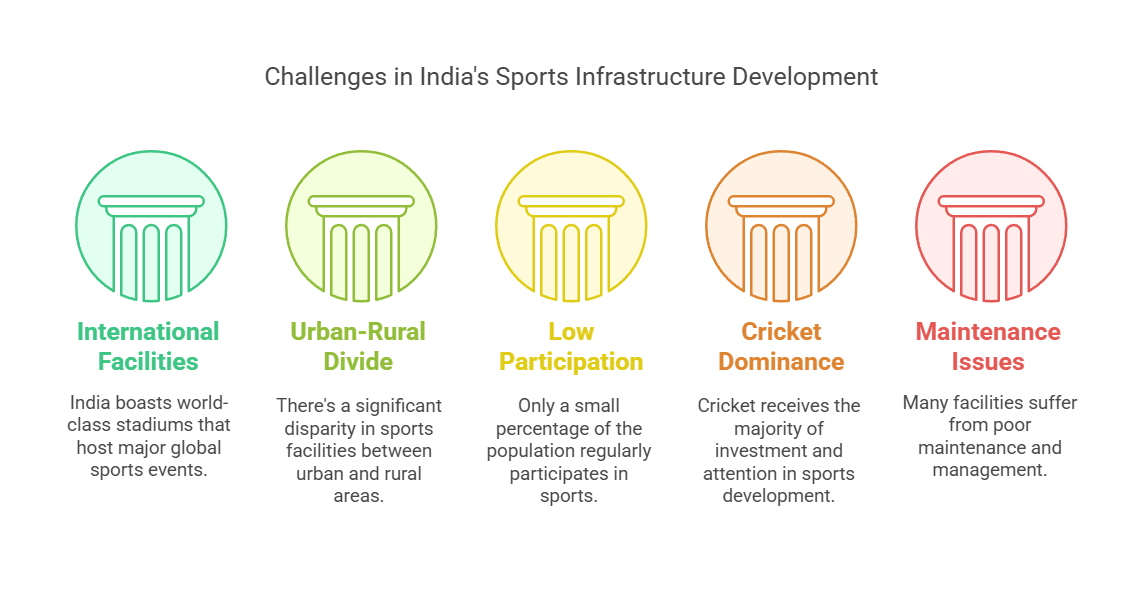
Sports Infrastructure in India: Growth, Challenges, and Future Prospects

India’s sports infrastructure has grown significantly in recent years. However, it still faces several challenges that hinder its full potential. In this article, we will explore the current state of sports infrastructure in India, why it is the way it is, ongoing improvements, and what more can be done to boost the sector.
Current State of Sports Infrastructure in India
India has made notable progress in building sports facilities, but the development remains uneven.
1. International Standard Facilities
India has over 100 world-class stadiums for sports like cricket, football, and hockey.
These venues have helped India host major events such as the Commonwealth Games, FIFA U-17 World Cup, and Hockey World Cup.
2. Urban vs. Rural Divide
Most high-quality sports facilities are in urban areas.
Rural regions lack proper stadiums, training centers, and basic sports infrastructure.
This gap limits the chances of discovering talent from smaller towns and villages.
3. Low Participation in Sports
Only 6% of India's population regularly participates in sports.
In comparison, countries like China (20%) and the USA (25%) have much higher participation rates.
Poor infrastructure and lack of encouragement are key reasons behind this.
4. Cricket Dominates Sports Development
Cricket receives most of the investment and attention in India.
Other sports like football, athletics, and hockey struggle with limited funding and poor infrastructure.
5. Maintenance Issues
Many stadiums and training centers lack proper maintenance.
Some facilities remain unused or abandoned due to poor management.

Why Is Sports Infrastructure Lagging in India?
Several factors have contributed to the slow growth of sports infrastructure in India.
Lack of Investment
Historically, sports infrastructure in India has received limited funding, with the majority of investments directed toward cricket. As a result, other sports have remained underdeveloped, lacking the necessary resources for growth and professional training.
Education System Focused on Academics
In many cases, academics take precedence over sports, with parents and schools prioritizing studies over athletic development. Unlike Western countries, where sports scholarships and career pathways are well-established, India has yet to widely promote structured opportunities for aspiring athletes.
Policy Gaps & Government Support
The absence of a national-level sports infrastructure policy has led to inconsistencies in development across states. Without a uniform framework, resource allocation remains uneven, hindering the growth of sports at a broader level.
Poor Grassroots Infrastructure
A lack of basic sports facilities in schools and colleges prevents early exposure to quality training environments. Without access to proper infrastructure from a young age, aspiring athletes struggle to develop their skills and compete at higher levels.

Steps Taken to Improve Sports Infrastructure
Despite the challenges, several government and private sector initiatives are helping improve India’s sports infrastructure.
Khelo India Program
Launched in 2018, the Khelo India Program aims to promote grassroots sports development across the country. Over 1,000 Khelo India Centres have been established to provide young athletes with training and resources. Additionally, more than 75 new sports infrastructure projects have been funded, enhancing facilities nationwide.
Government Investment
The Ministry of Youth Affairs & Sports has approved 323 new sports projects with a budget of ₹3,073 crore, reinforcing the government's commitment to sports development. Furthermore, 1,041 Khelo India Centres and 32 Khelo India State Centres of Excellence have been set up to nurture talent and improve training standards.
Rise of Private Investments
Private companies are playing a significant role in expanding sports infrastructure in India. Organizations like Decathlon, Tata Trusts, and Reliance Foundation are investing in facilities and equipment to make sports more accessible. Decathlon alone has 129 stores and 5,700 employees in India, ensuring easy access to quality sports gear and training resources.
How Can India Further Improve Its Sports Infrastructure?
While progress is being made, India needs to take additional steps to ensure a strong sports ecosystem.
1. More Public-Private Partnerships (PPP)
Governments should collaborate with private companies to build and maintain sports facilities.
This will ensure better funding, technology, and management.
2. Focus on Rural & Grassroots Development
Invest in smaller towns and rural areas to bridge the urban-rural gap.
Provide training centers and scholarships to identify and nurture hidden talent.
3. School & University Sports Development
Make sports a compulsory part of the education system.
Encourage schools and colleges to invest in modern sports infrastructure.
4. Multi-Sport Development
Move away from a cricket-centric approach.
Promote other sports like football, athletics, hockey, badminton, and swimming.
5. Better Maintenance & Utilization of Existing Infrastructure
Introduce sports infrastructure management policies to keep facilities in good condition.
Use underutilized stadiums for multi-purpose sporting events.
Partnering with Michezo Sports for World-Class Sports Infrastructure
India is making steady progress in sports infrastructure, but there is still a long way to go. By investing in grassroots development, improving accessibility, and maintaining facilities, India can create a world-class sports ecosystem.
The future of sports infrastructure in India depends on visionary execution and expert solutions. At Michezo Sports, we specialize in designing and constructing high-quality sports facilities that meet international standards. Whether it's school and university sports complexes, professional stadiums, synthetic turf fields, or multi-sport courts, our team delivers cutting-edge solutions tailored to your needs.
With India’s growing passion for sports, now is the time to invest in world-class sports facilities. Whether you're looking to build a state-of-the-art football turf, pickleball court, or an advanced multi-sport facility.



